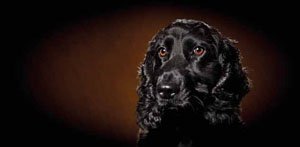articles/Portraiture/dogowner-page2
You have to be a dog owner to understand - part 2 of 1 2 3
by Stuart Walker Published 01/10/2011

One of the most important aspects of photography is connecting with your subject. We have all seen images of bored subjects with fixed grins and zero interaction and thought 'what an awful photograph'. It might seem strange but even when your subject is an animal with a vocabulary more limited than a premier league football player, they still need direction. If you have experience of shooting images of toddlers it will come as no surprise that shiny things, funny noises and the odd tasty treat go a long way to getting the best pose and expression from a pet. Some dogs are better trained than others of course and patience is definitely a virtue when working with animals!
It helps to take some time before the shoot to brief the owner about the session - where they should stand, where to hold the treats, where to relocate the dog if they wander too far, etc. This briefing will also allow time for the dog to sniff you out and become more settled with the equipment if already set up. Remember that as with parents of children, dog owners can become anxious if their pet isn't behaving well in front of the camera and they might need gentle encouragement to calm down themselves.ADD
Always consider the welfare of the animal during a photography session and be prepared to cut the session short if the pet is showing any signs of distress - in some cases your own safety could be compromised with little warning if an uncomfortable situation becomes too much for it. There are many subtle warning signs that can indicate the mood of a dog, but if it starts staring at you while emitting a low, deep growl then it is definitely time to say goodbye!

You should already have in mind before the session starts what kind of image you are seeking to create. We are image makers, not takers, after all. My preferred choice with dark-coated dogs is using a black background and plenty of light to highlight the pattern of light reflecting off the shiny fur, although rough-haired dogs are less suitable. The eyes can give an excellent representation of a dog's character and should be well lit with appropriate post-processing to enhance them if required. Animals don't have to look 'cute and cuddly' all the time and I much prefer a dark, moody look to my images.
Simple lighting works well with furry animals and is of benefit when setting up a mobile studio in the owner's home. Being proficient with off-camera flash and having the appropriate light modifiers also means that you always have the light to create the image you want.
Take the images here of the Cocker Spaniel and the Siberian Husky. They both look very similar and, indeed, the one of the Spaniel was taken while perfecting the technique used to elicit the expression of the Husky - a dog with intense blue eyes that I had planned to photograph for some time. By knowing exactly what I wanted to achieve and how I was going to do it, the image in my mind finally ended up in print and it is surely no coincidence that these carefully planned images led to me winning The Societies' 'Pet Photographer of the Year' in January 2011. These images were shot using just a single speedlite and a 19'' DMLS beauty dish.
Please Note:
There is more than one page for this Article.
You are currently on page 2
- You have to be a dog owner to understand page 1
- You have to be a dog owner to understand page 2
- You have to be a dog owner to understand page 3
1st Published 01/10/2011
last update 09/12/2022 14:53:25
More Portraiture Articles
There are 0 days to get ready for The Society of Photographers Convention and Trade Show at The Novotel London West, Hammersmith ...
which starts on Wednesday 15th January 2025





